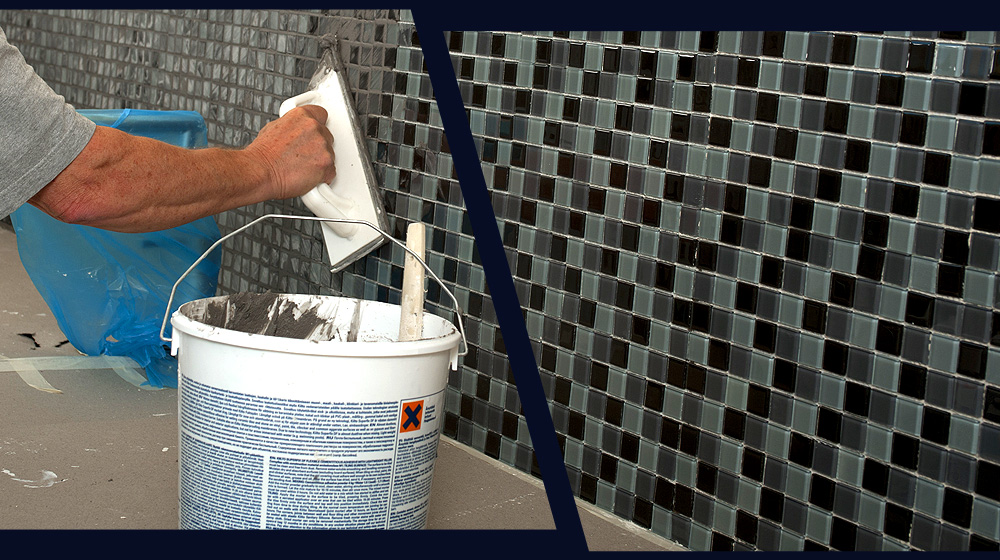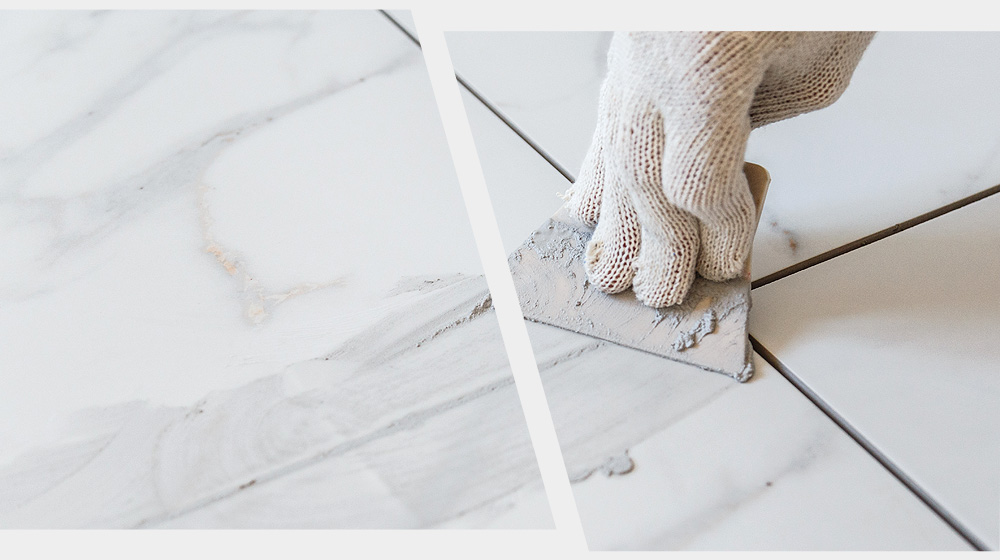A Guide to
Choosing the
Right Grout for
Your Tiles
Grouting is crucial to any tiling project, playing a role beyond simply filling the gaps between tiles. Grout ensures structural integrity, prevents water seepage, and contributes significantly to the overall aesthetic of the tiled surface. The right choice of grout can enhance the visual appeal of your tiles, while the wrong choice can detract from their beauty and functionality.
In this guide, we will explore everything you need to know about choosing the right grout for your tiles. Whether you are undertaking a home renovation or a commercial tiling project, this guide will help you make informed decisions to achieve a professional and long-lasting finish.

What is Grout and Why is it So Important?


Grout is an essential material in tiling projects, used to fill the gaps between tiles, ensuring they remain securely in place. Its primary purpose extends beyond mere aesthetic appeal, as it also helps prevent moisture from seeping underneath the tiles, which can cause damage and promote mould growth. Moreover, grout contributes to the overall durability and stability of the tiled surface, making it a crucial component in both residential and commercial tiling applications.

Types of Grout


Cement-based Grout
Cement-based grout is the most traditional and widely used type of grout. It is known for its versatility and ease of application. This grout comes in two main varieties: sanded and unsanded. Sanded grout contains fine sand, making it suitable for wider joints as it provides added strength and stability. Unsanded grout, on the other hand, has a smoother texture and is best suited for narrower joints. Typically, cement-based grout is mixed with water, and sometimes latex additives are added to improve its performance and flexibility.
Pros
-
Cost-effective
-
Easy to apply
-
Widely available
-
Versatile, suitable for many tiling projects
Cons
-
Requires sealing to prevent stains and moisture absorption
-
Prone to stains and mould without proper sealing
-
Can crack over time if not properly maintained
-
Maintenance required, especially in high-traffic areas
Cement-based grout is ideal for most residential and commercial tiling projects, including bathrooms, kitchens, and living areas. Sanded grout is particularly suitable for floor tiles and wider joints, where additional strength is required. Unsanded grout, with its smoother texture, is well-suited for wall tiles and narrow joints, providing a clean and polished finish.
Epoxy Grout
Epoxy grout is renowned for its durability and resistance to stains and chemicals. It is composed of epoxy resins and a filler powder, creating a non-porous and highly resilient material. This type of grout is less prone to mould and mildew, making it an excellent choice for areas exposed to moisture and harsh conditions. Epoxy grout does not require sealing, which reduces maintenance efforts and enhances its longevity.
Pros
-
Exceptionally durable
-
Highly resistant to stains, chemicals, and moisture
-
Non-porous, less likely to harbour mould and mildew
-
No need for sealing
Cons
-
Generally more expensive than cement-based grout
-
Challenging to apply, requires careful handling
-
Sets quickly, can be difficult to clean off tiles if not managed properly
-
Requires more effort and skill during installation
Epoxy grout is best suited for areas exposed to harsh conditions and high moisture, such as kitchens, bathrooms, and swimming pools. Its superior resistance to stains and chemicals makes it ideal for commercial settings where hygiene and durability are paramount. Despite its higher cost and application challenges, the benefits of epoxy grout often outweigh these drawbacks in demanding environments.
Urethane Grout
Urethane grout is a relatively newer option known for its flexibility and water resistance. It is pre-mixed and ready to use, which simplifies the application process. This type of grout is highly durable, capable of withstanding movement and vibration, making it suitable for a variety of substrates and environments. Urethane grout also offers excellent stain resistance and does not require sealing, further enhancing its appeal for both residential and commercial applications.
Pros
-
Flexible, absorbs movement and vibration
-
Water-resistant
-
Pre-mixed, easy to use
-
Reduces preparation time and errors
-
Excellent stain resistance
-
No need for sealing, low maintenance
Cons
-
Generally more expensive than cement-based grout
Urethane grout is suitable for a wide range of applications, including both residential and commercial settings. Its water resistance makes it ideal for bathrooms, kitchens, and other areas exposed to moisture. Its flexibility and durability also make it suitable for floors and areas subject to movement and vibration, such as around windows and doors. While it may be more costly, the benefits of urethane grout in terms of ease of use and low maintenance make it a worthwhile investment for many projects.

Choosing the Right Grout Colour


The grout colour you choose can have a big effect on the overall design and aesthetic of your tiled surface. It can either blend seamlessly with the tiles, creating a uniform look, or stand out to highlight the tile pattern and layout.
Matching Grout
Matching grout is used when you want a seamless and cohesive look. It is ideal for creating a unified surface where the grout lines blend in with the tiles, making the overall design look more fluid and continuous. This approach is particularly effective with tiles that have a distinct pattern or texture, as it allows the tile design to be the focal point without interruption.
Using grout that matches the tile colour results in a sleek and minimalistic appearance. For instance, white grout with white tiles creates a clean and modern look, often used in contemporary bathroom and kitchen designs. Similarly, matching grey grout with grey tiles can give a sophisticated and understated elegance to floors and walls.
Contrasting Grout
Contrasting grout is used when you want to highlight the tile pattern and layout. It draws attention to the shape and arrangement of the tiles, creating a bold and eye-catching effect. This approach is suitable for geometric patterns, mosaics, or when you want to make a design statement with your tiling.
Using a contrasting grout colour can make the tiles stand out and create a dramatic effect. For example, black grout with white subway tiles creates a classic and timeless look, often seen in traditional and industrial-style interiors. Conversely, white grout with dark tiles can brighten up the space and emphasise the individual tiles, making the design more pronounced.
Neutral Grout Colours
Neutral grout colours offer versatility and a balanced look, making them a safe choice for those who want a subtle and harmonious finish without drawing too much attention to the grout lines. Neutral grouts are less likely to clash with tile colours and can complement a wide range of tile designs.
Popular Neutral Colours and Their Effects
-
Beige Grout: Works well with natural stone tiles and earthy tones, adding warmth and a cohesive feel to the design.
-
Grey Grout: A popular choice for both light and dark tiles, grey grout provides a modern and sophisticated look. It is also practical, as it is less likely to show dirt and stains compared to white grout.
-
Off-white Grout: Offers a softer alternative to pure white grout, creating a light and airy feel without the starkness of white. It pairs well with pastel and light-coloured tiles for a subtle yet elegant finish.

How to Apply Grout

Proper grout application is crucial for achieving a professional finish and ensuring the longevity of your tiled surfaces.

Preparation: Cleaning and Sealing Tiles
Thoroughly clean the tiles and the gaps between them before applying grout. Any debris, dust, or adhesive residue can prevent the grout from adhering properly, leading to an uneven finish and potential future issues. Use a damp sponge to wipe down the tiles and a vacuum or brush to clean out the joints. Ensure the tiles are dry before proceeding to the next step.
If you are using porous tiles such as natural stone, it is advisable to seal them before grouting. Sealing the tiles prevents the grout from staining or sticking to the tile surface, making the cleanup process easier and ensuring a clean, professional look. Apply a tile sealer according to the manufacturer’s instructions and allow it to dry completely.
Shop Cleaning & Sealing Products
Grout Application Tips for a Professional Finish
-
Apply Grout: Use a rubber grout float to spread the grout over the tiles. Hold the float at a 45-degree angle and press the grout into the joints, ensuring they are fully filled. Work in small sections to prevent the grout from drying out before you can clean it.
-
Remove Excess Grout: After filling the joints, hold the float at a sharp angle and scrape off excess grout from the tile surface. This step helps to minimise the amount of grout you need to clean later.
-
Initial Cleaning: Allow the grout to set for about 15-30 minutes, or until it starts to firm up. Use a damp sponge to gently wipe off the grout haze from the tile surface, rinsing the sponge frequently. Be careful not to drag too much grout out of the joints.
-
Final Cleaning: Once the grout has cured for the recommended time (usually 24 hours), use a dry cloth or a grout haze remover to polish the tiles and remove any remaining residue. For textured tiles, you may need a stiff brush to clean grout trapped in the crevices.
If you are using porous tiles such as natural stone, it is advisable to seal them before grouting. Sealing the tiles prevents the grout from staining or sticking to the tile surface, making the cleanup process easier and ensuring a clean, professional look. Apply a tile sealer according to the manufacturer’s instructions and allow it to dry completely.
Read Our Guide to Cleaning Grout
Common Mistakes to Avoid
-
Incorrect Mixing Ratio: Adding too much or too little water can weaken the grout and affect its performance. Always follow the manufacturer's instructions.
-
Not Allowing Grout to Slake: Skipping the slaking step can lead to uneven consistency and reduced strength. Let the grout sit as recommended before the final stir.
-
Improper Cleaning: Cleaning the tiles too soon or too late can cause issues. If cleaned too soon, the grout may be pulled out of the joints; if too late, the grout haze becomes harder to remove.
-
Skipping Sealing: Not sealing porous tiles before grouting can lead to permanent stains and a less professional finish.

Find The Right Grout For Your Tiling Project

Choosing the right grout is essential for the success of any tiling project. Whether you're renovating your bathroom, updating your kitchen, or tackling a commercial tiling job, the right grout ensures durability, prevents water damage, and enhances the aesthetic appeal of your tiles.
Explore our range of grout options at Target Tiles to find the perfect match for your needs. With our detailed guide and high-quality products, you can achieve a professional and long-lasting finish.
Recent Posts
Why Choose Us?
- Free Delivery over £249*
- Free Sample Delivery*
- 10,000 Square Meters in Stock




